Project Life Cycle: Risk Management in Hybrid Vehicle Design Project
VerifiedAdded on 2021/06/17
|10
|2314
|265
Project
AI Summary
This project delves into the intricacies of the project life cycle, examining its various phases, including initiation, planning, execution, and closure. It emphasizes the importance of effective risk management throughout the project's duration, highlighting potential risks such as resource scarcity, time and cost overruns, and quality compromises. The assignment explores the implications of these risks on a design team, specifically in the context of designing a new hybrid passenger vehicle. It outlines strategies for anticipating, measuring, and mitigating risks, including the development of contingency plans. The analysis underscores the necessity for efficient resource management, adherence to timelines, and a commitment to maintaining high-quality standards to ensure project success. The project highlights that risks must be identified and managed to overcome them and ensure the project meets its specifications within the time frame. The assignment stresses the importance of proactive risk assessment, strategic planning, and continuous monitoring to achieve desired project outcomes, providing a comprehensive understanding of how to navigate the complexities of project management.
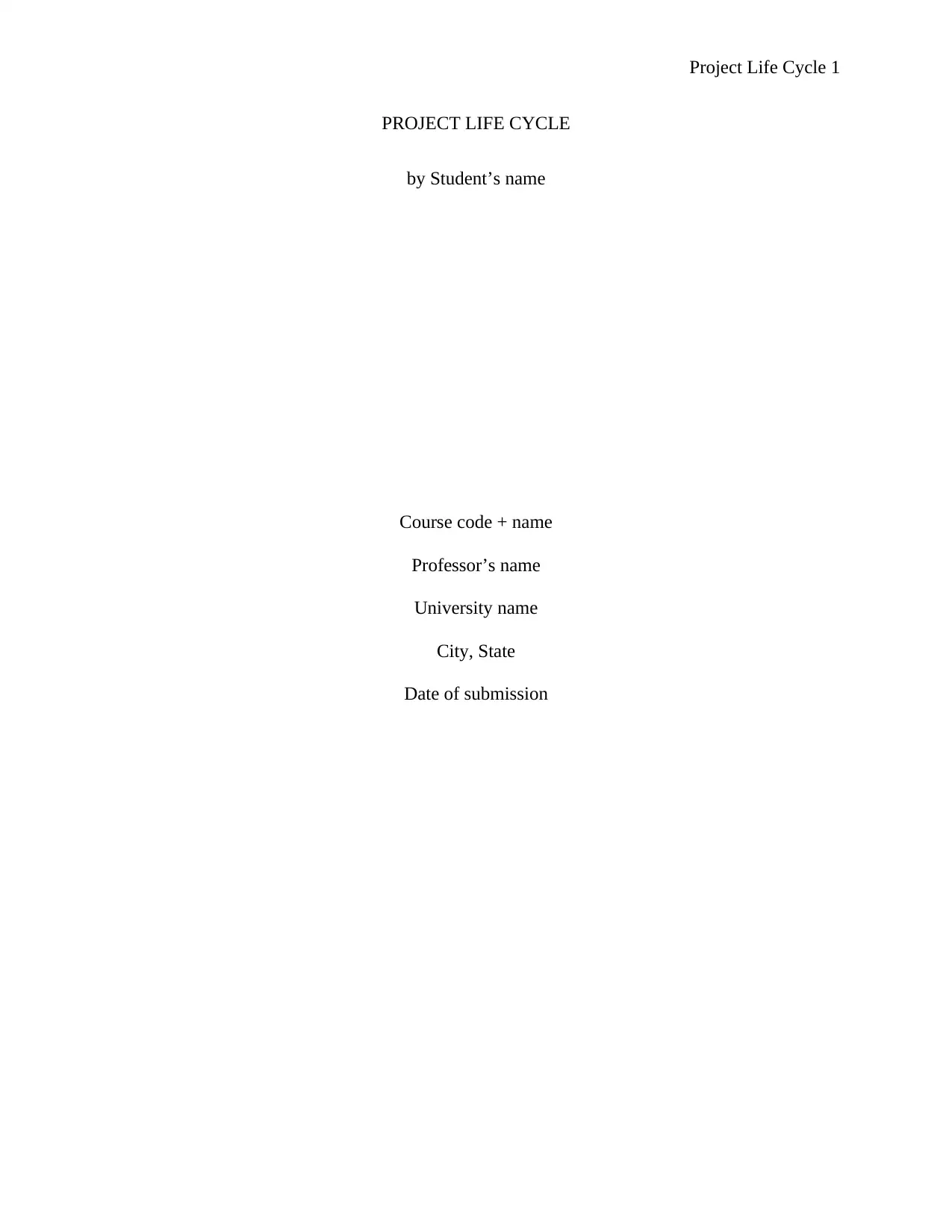
Project Life Cycle 1
PROJECT LIFE CYCLE
by Student’s name
Course code + name
Professor’s name
University name
City, State
Date of submission
PROJECT LIFE CYCLE
by Student’s name
Course code + name
Professor’s name
University name
City, State
Date of submission
Paraphrase This Document
Need a fresh take? Get an instant paraphrase of this document with our AI Paraphraser
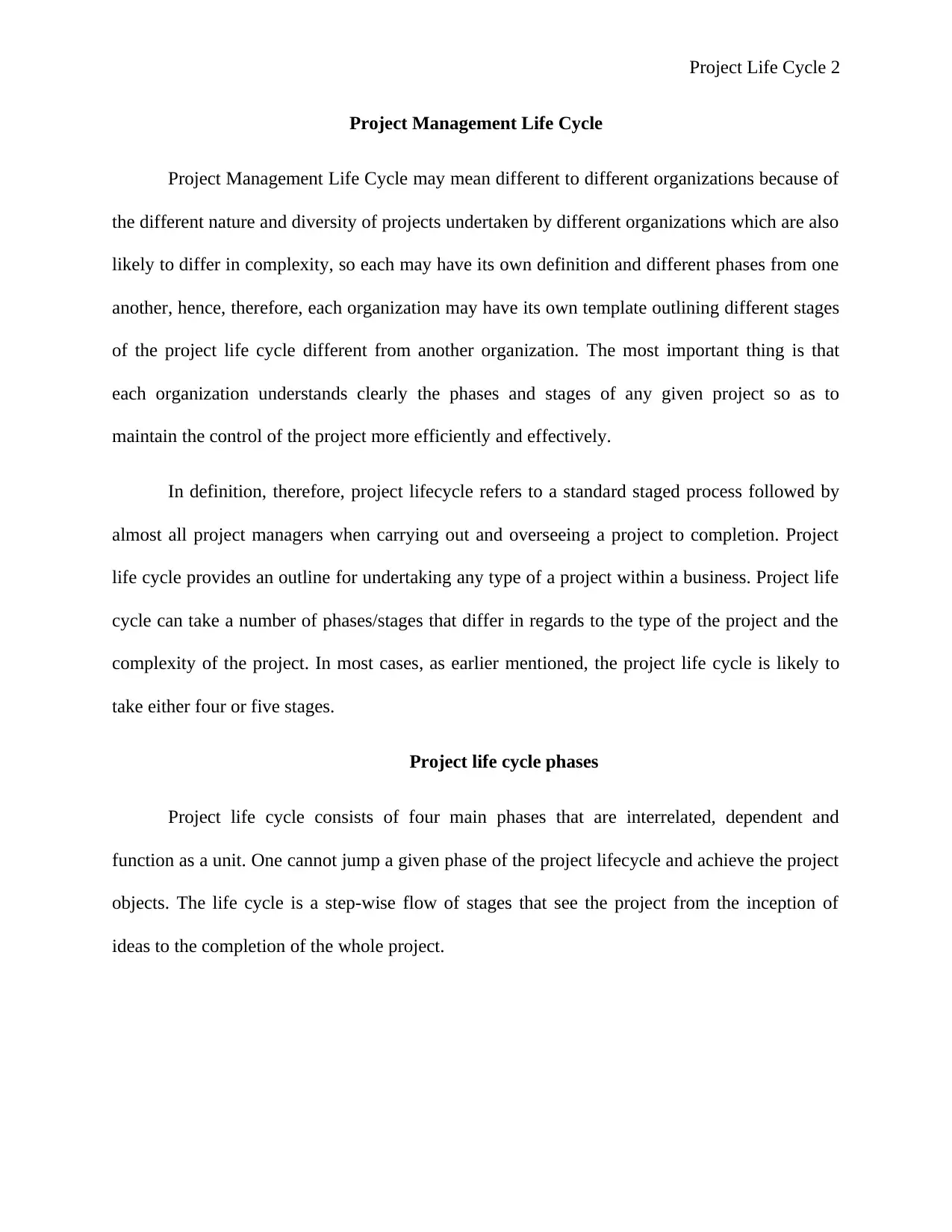
Project Life Cycle 2
Project Management Life Cycle
Project Management Life Cycle may mean different to different organizations because of
the different nature and diversity of projects undertaken by different organizations which are also
likely to differ in complexity, so each may have its own definition and different phases from one
another, hence, therefore, each organization may have its own template outlining different stages
of the project life cycle different from another organization. The most important thing is that
each organization understands clearly the phases and stages of any given project so as to
maintain the control of the project more efficiently and effectively.
In definition, therefore, project lifecycle refers to a standard staged process followed by
almost all project managers when carrying out and overseeing a project to completion. Project
life cycle provides an outline for undertaking any type of a project within a business. Project life
cycle can take a number of phases/stages that differ in regards to the type of the project and the
complexity of the project. In most cases, as earlier mentioned, the project life cycle is likely to
take either four or five stages.
Project life cycle phases
Project life cycle consists of four main phases that are interrelated, dependent and
function as a unit. One cannot jump a given phase of the project lifecycle and achieve the project
objects. The life cycle is a step-wise flow of stages that see the project from the inception of
ideas to the completion of the whole project.
Project Management Life Cycle
Project Management Life Cycle may mean different to different organizations because of
the different nature and diversity of projects undertaken by different organizations which are also
likely to differ in complexity, so each may have its own definition and different phases from one
another, hence, therefore, each organization may have its own template outlining different stages
of the project life cycle different from another organization. The most important thing is that
each organization understands clearly the phases and stages of any given project so as to
maintain the control of the project more efficiently and effectively.
In definition, therefore, project lifecycle refers to a standard staged process followed by
almost all project managers when carrying out and overseeing a project to completion. Project
life cycle provides an outline for undertaking any type of a project within a business. Project life
cycle can take a number of phases/stages that differ in regards to the type of the project and the
complexity of the project. In most cases, as earlier mentioned, the project life cycle is likely to
take either four or five stages.
Project life cycle phases
Project life cycle consists of four main phases that are interrelated, dependent and
function as a unit. One cannot jump a given phase of the project lifecycle and achieve the project
objects. The life cycle is a step-wise flow of stages that see the project from the inception of
ideas to the completion of the whole project.
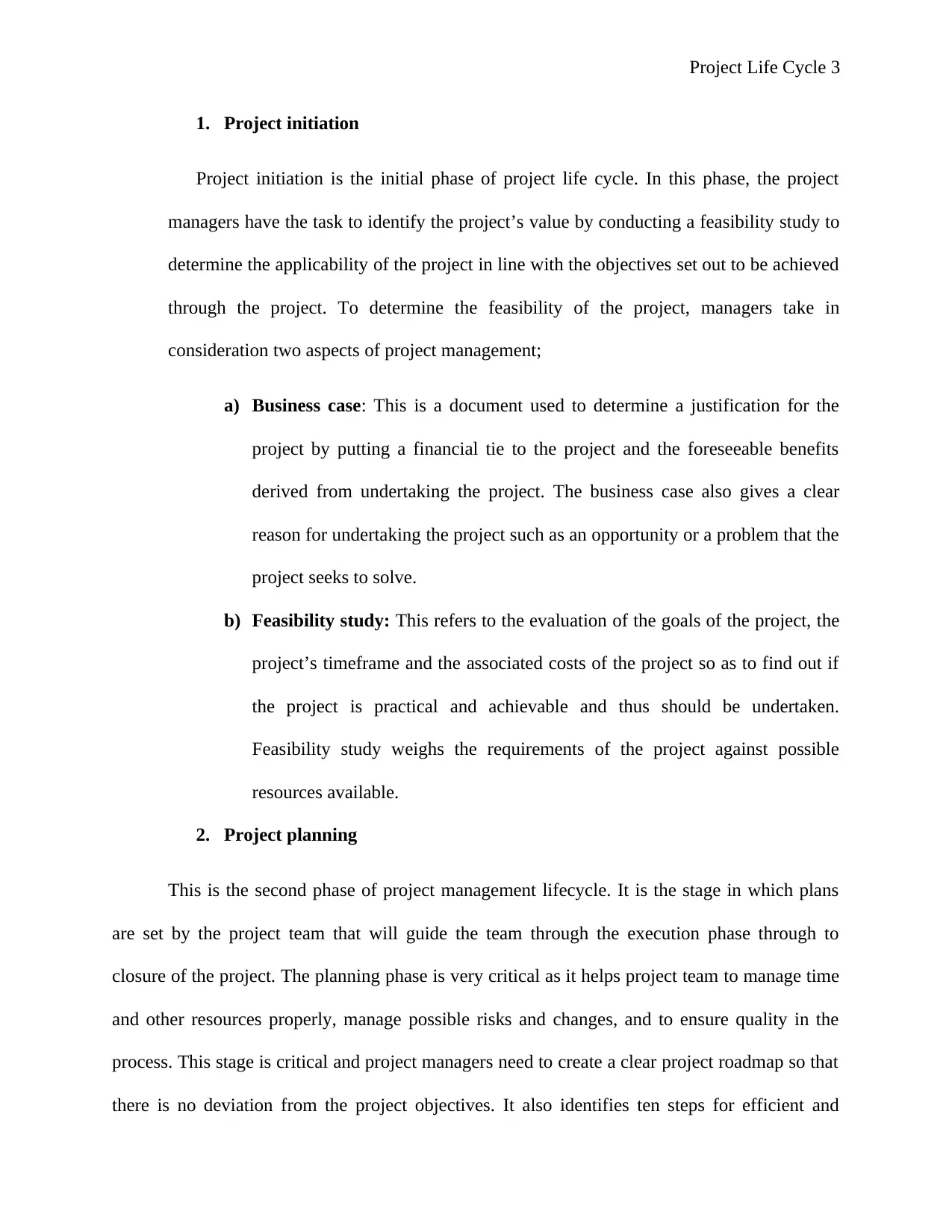
Project Life Cycle 3
1. Project initiation
Project initiation is the initial phase of project life cycle. In this phase, the project
managers have the task to identify the project’s value by conducting a feasibility study to
determine the applicability of the project in line with the objectives set out to be achieved
through the project. To determine the feasibility of the project, managers take in
consideration two aspects of project management;
a) Business case: This is a document used to determine a justification for the
project by putting a financial tie to the project and the foreseeable benefits
derived from undertaking the project. The business case also gives a clear
reason for undertaking the project such as an opportunity or a problem that the
project seeks to solve.
b) Feasibility study: This refers to the evaluation of the goals of the project, the
project’s timeframe and the associated costs of the project so as to find out if
the project is practical and achievable and thus should be undertaken.
Feasibility study weighs the requirements of the project against possible
resources available.
2. Project planning
This is the second phase of project management lifecycle. It is the stage in which plans
are set by the project team that will guide the team through the execution phase through to
closure of the project. The planning phase is very critical as it helps project team to manage time
and other resources properly, manage possible risks and changes, and to ensure quality in the
process. This stage is critical and project managers need to create a clear project roadmap so that
there is no deviation from the project objectives. It also identifies ten steps for efficient and
1. Project initiation
Project initiation is the initial phase of project life cycle. In this phase, the project
managers have the task to identify the project’s value by conducting a feasibility study to
determine the applicability of the project in line with the objectives set out to be achieved
through the project. To determine the feasibility of the project, managers take in
consideration two aspects of project management;
a) Business case: This is a document used to determine a justification for the
project by putting a financial tie to the project and the foreseeable benefits
derived from undertaking the project. The business case also gives a clear
reason for undertaking the project such as an opportunity or a problem that the
project seeks to solve.
b) Feasibility study: This refers to the evaluation of the goals of the project, the
project’s timeframe and the associated costs of the project so as to find out if
the project is practical and achievable and thus should be undertaken.
Feasibility study weighs the requirements of the project against possible
resources available.
2. Project planning
This is the second phase of project management lifecycle. It is the stage in which plans
are set by the project team that will guide the team through the execution phase through to
closure of the project. The planning phase is very critical as it helps project team to manage time
and other resources properly, manage possible risks and changes, and to ensure quality in the
process. This stage is critical and project managers need to create a clear project roadmap so that
there is no deviation from the project objectives. It also identifies ten steps for efficient and
⊘ This is a preview!⊘
Do you want full access?
Subscribe today to unlock all pages.

Trusted by 1+ million students worldwide
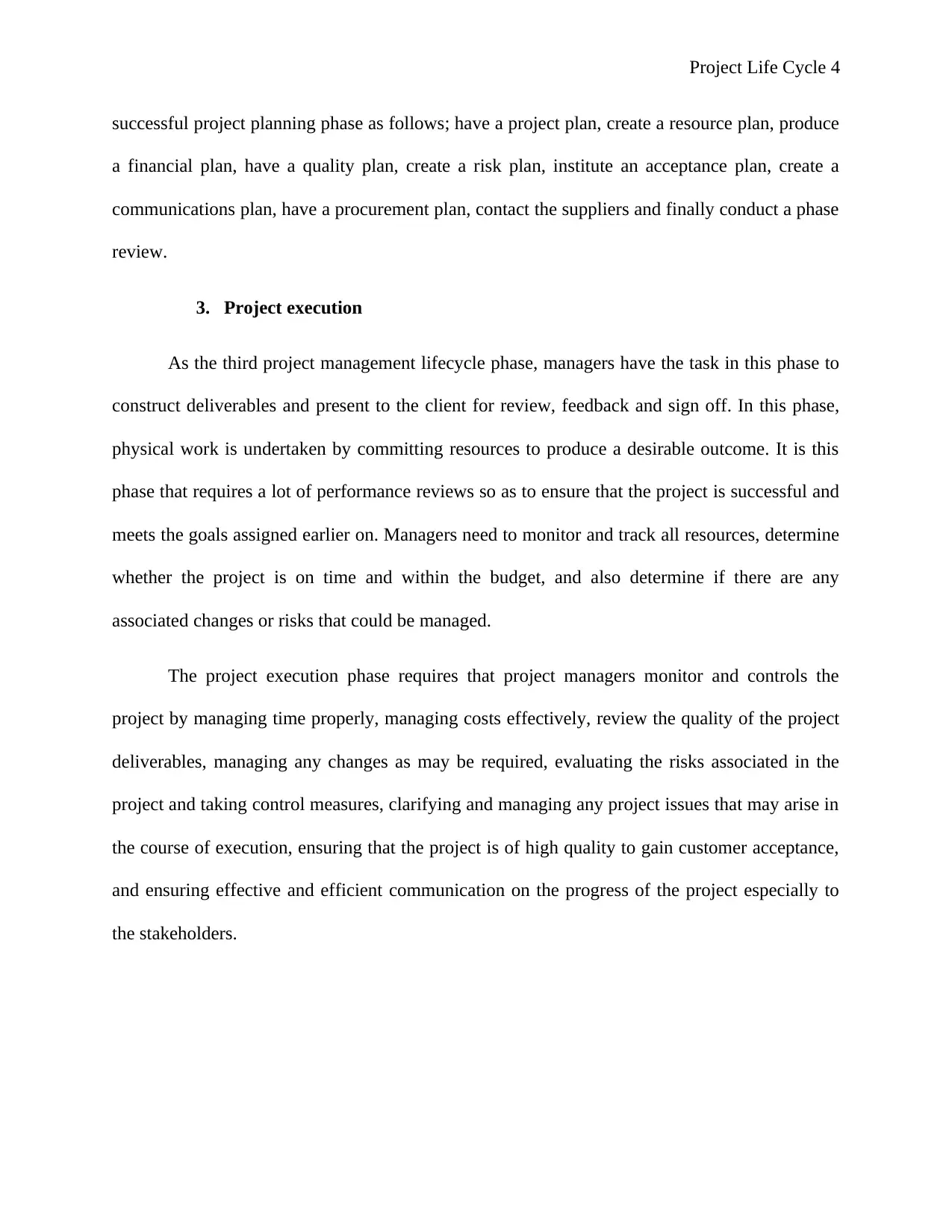
Project Life Cycle 4
successful project planning phase as follows; have a project plan, create a resource plan, produce
a financial plan, have a quality plan, create a risk plan, institute an acceptance plan, create a
communications plan, have a procurement plan, contact the suppliers and finally conduct a phase
review.
3. Project execution
As the third project management lifecycle phase, managers have the task in this phase to
construct deliverables and present to the client for review, feedback and sign off. In this phase,
physical work is undertaken by committing resources to produce a desirable outcome. It is this
phase that requires a lot of performance reviews so as to ensure that the project is successful and
meets the goals assigned earlier on. Managers need to monitor and track all resources, determine
whether the project is on time and within the budget, and also determine if there are any
associated changes or risks that could be managed.
The project execution phase requires that project managers monitor and controls the
project by managing time properly, managing costs effectively, review the quality of the project
deliverables, managing any changes as may be required, evaluating the risks associated in the
project and taking control measures, clarifying and managing any project issues that may arise in
the course of execution, ensuring that the project is of high quality to gain customer acceptance,
and ensuring effective and efficient communication on the progress of the project especially to
the stakeholders.
successful project planning phase as follows; have a project plan, create a resource plan, produce
a financial plan, have a quality plan, create a risk plan, institute an acceptance plan, create a
communications plan, have a procurement plan, contact the suppliers and finally conduct a phase
review.
3. Project execution
As the third project management lifecycle phase, managers have the task in this phase to
construct deliverables and present to the client for review, feedback and sign off. In this phase,
physical work is undertaken by committing resources to produce a desirable outcome. It is this
phase that requires a lot of performance reviews so as to ensure that the project is successful and
meets the goals assigned earlier on. Managers need to monitor and track all resources, determine
whether the project is on time and within the budget, and also determine if there are any
associated changes or risks that could be managed.
The project execution phase requires that project managers monitor and controls the
project by managing time properly, managing costs effectively, review the quality of the project
deliverables, managing any changes as may be required, evaluating the risks associated in the
project and taking control measures, clarifying and managing any project issues that may arise in
the course of execution, ensuring that the project is of high quality to gain customer acceptance,
and ensuring effective and efficient communication on the progress of the project especially to
the stakeholders.
Paraphrase This Document
Need a fresh take? Get an instant paraphrase of this document with our AI Paraphraser
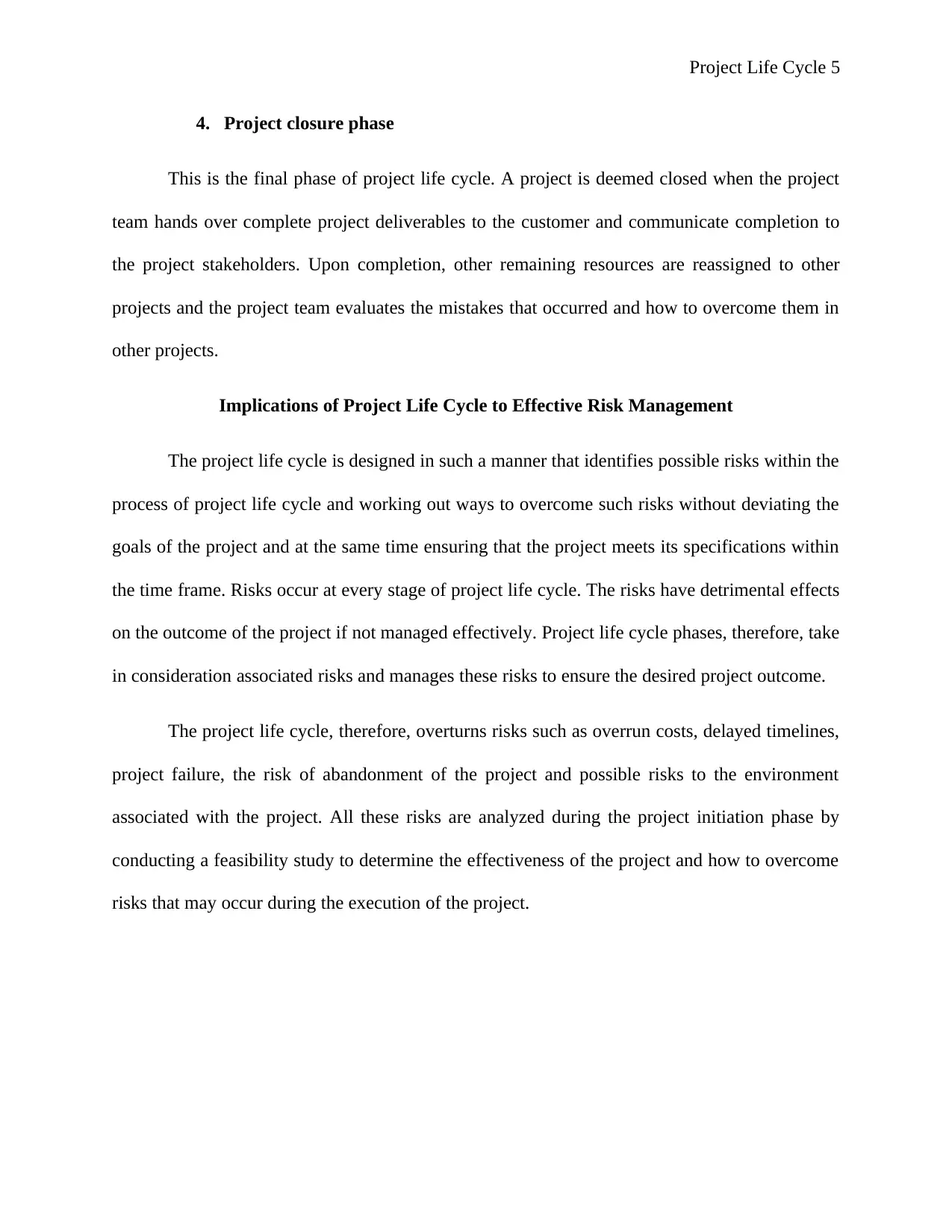
Project Life Cycle 5
4. Project closure phase
This is the final phase of project life cycle. A project is deemed closed when the project
team hands over complete project deliverables to the customer and communicate completion to
the project stakeholders. Upon completion, other remaining resources are reassigned to other
projects and the project team evaluates the mistakes that occurred and how to overcome them in
other projects.
Implications of Project Life Cycle to Effective Risk Management
The project life cycle is designed in such a manner that identifies possible risks within the
process of project life cycle and working out ways to overcome such risks without deviating the
goals of the project and at the same time ensuring that the project meets its specifications within
the time frame. Risks occur at every stage of project life cycle. The risks have detrimental effects
on the outcome of the project if not managed effectively. Project life cycle phases, therefore, take
in consideration associated risks and manages these risks to ensure the desired project outcome.
The project life cycle, therefore, overturns risks such as overrun costs, delayed timelines,
project failure, the risk of abandonment of the project and possible risks to the environment
associated with the project. All these risks are analyzed during the project initiation phase by
conducting a feasibility study to determine the effectiveness of the project and how to overcome
risks that may occur during the execution of the project.
4. Project closure phase
This is the final phase of project life cycle. A project is deemed closed when the project
team hands over complete project deliverables to the customer and communicate completion to
the project stakeholders. Upon completion, other remaining resources are reassigned to other
projects and the project team evaluates the mistakes that occurred and how to overcome them in
other projects.
Implications of Project Life Cycle to Effective Risk Management
The project life cycle is designed in such a manner that identifies possible risks within the
process of project life cycle and working out ways to overcome such risks without deviating the
goals of the project and at the same time ensuring that the project meets its specifications within
the time frame. Risks occur at every stage of project life cycle. The risks have detrimental effects
on the outcome of the project if not managed effectively. Project life cycle phases, therefore, take
in consideration associated risks and manages these risks to ensure the desired project outcome.
The project life cycle, therefore, overturns risks such as overrun costs, delayed timelines,
project failure, the risk of abandonment of the project and possible risks to the environment
associated with the project. All these risks are analyzed during the project initiation phase by
conducting a feasibility study to determine the effectiveness of the project and how to overcome
risks that may occur during the execution of the project.
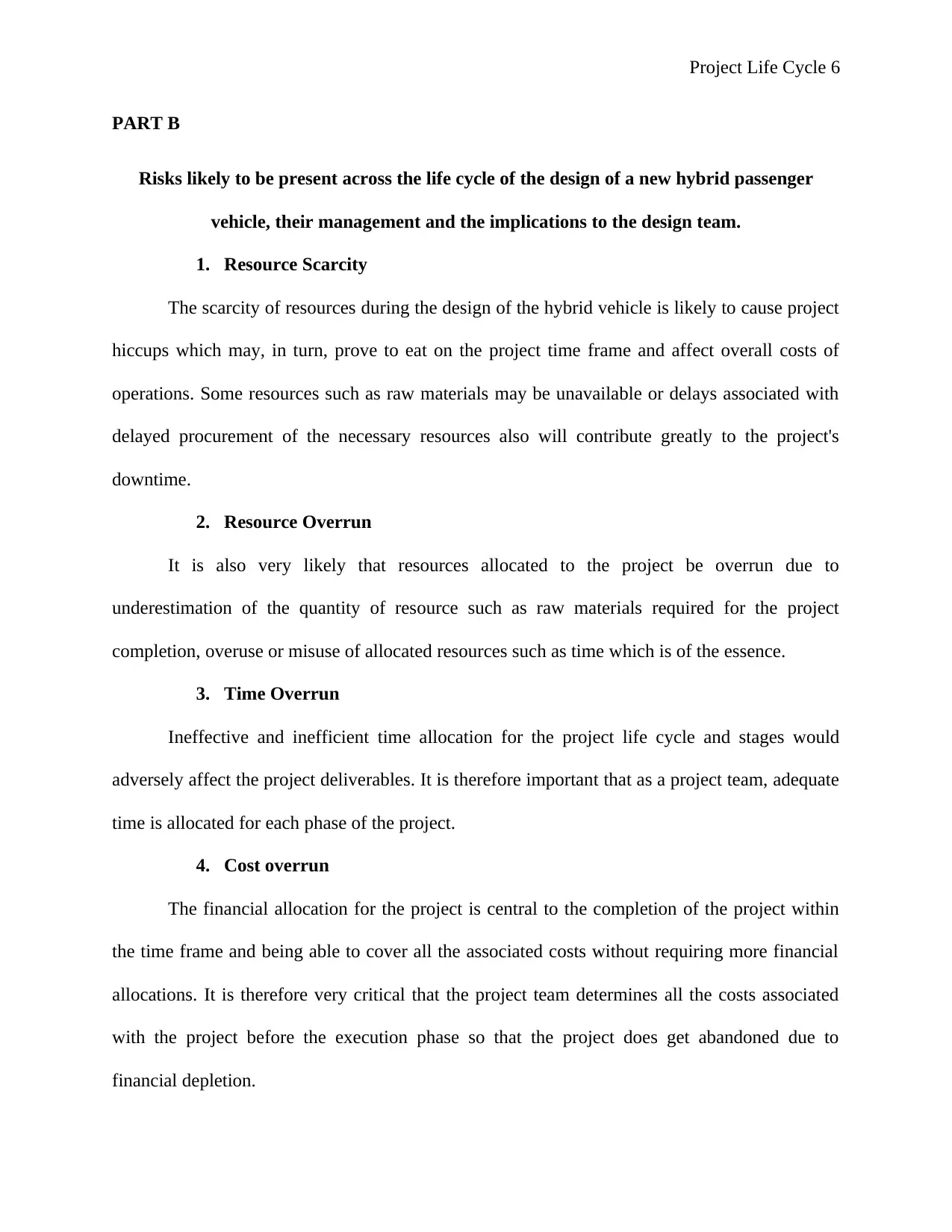
Project Life Cycle 6
PART B
Risks likely to be present across the life cycle of the design of a new hybrid passenger
vehicle, their management and the implications to the design team.
1. Resource Scarcity
The scarcity of resources during the design of the hybrid vehicle is likely to cause project
hiccups which may, in turn, prove to eat on the project time frame and affect overall costs of
operations. Some resources such as raw materials may be unavailable or delays associated with
delayed procurement of the necessary resources also will contribute greatly to the project's
downtime.
2. Resource Overrun
It is also very likely that resources allocated to the project be overrun due to
underestimation of the quantity of resource such as raw materials required for the project
completion, overuse or misuse of allocated resources such as time which is of the essence.
3. Time Overrun
Ineffective and inefficient time allocation for the project life cycle and stages would
adversely affect the project deliverables. It is therefore important that as a project team, adequate
time is allocated for each phase of the project.
4. Cost overrun
The financial allocation for the project is central to the completion of the project within
the time frame and being able to cover all the associated costs without requiring more financial
allocations. It is therefore very critical that the project team determines all the costs associated
with the project before the execution phase so that the project does get abandoned due to
financial depletion.
PART B
Risks likely to be present across the life cycle of the design of a new hybrid passenger
vehicle, their management and the implications to the design team.
1. Resource Scarcity
The scarcity of resources during the design of the hybrid vehicle is likely to cause project
hiccups which may, in turn, prove to eat on the project time frame and affect overall costs of
operations. Some resources such as raw materials may be unavailable or delays associated with
delayed procurement of the necessary resources also will contribute greatly to the project's
downtime.
2. Resource Overrun
It is also very likely that resources allocated to the project be overrun due to
underestimation of the quantity of resource such as raw materials required for the project
completion, overuse or misuse of allocated resources such as time which is of the essence.
3. Time Overrun
Ineffective and inefficient time allocation for the project life cycle and stages would
adversely affect the project deliverables. It is therefore important that as a project team, adequate
time is allocated for each phase of the project.
4. Cost overrun
The financial allocation for the project is central to the completion of the project within
the time frame and being able to cover all the associated costs without requiring more financial
allocations. It is therefore very critical that the project team determines all the costs associated
with the project before the execution phase so that the project does get abandoned due to
financial depletion.
⊘ This is a preview!⊘
Do you want full access?
Subscribe today to unlock all pages.

Trusted by 1+ million students worldwide
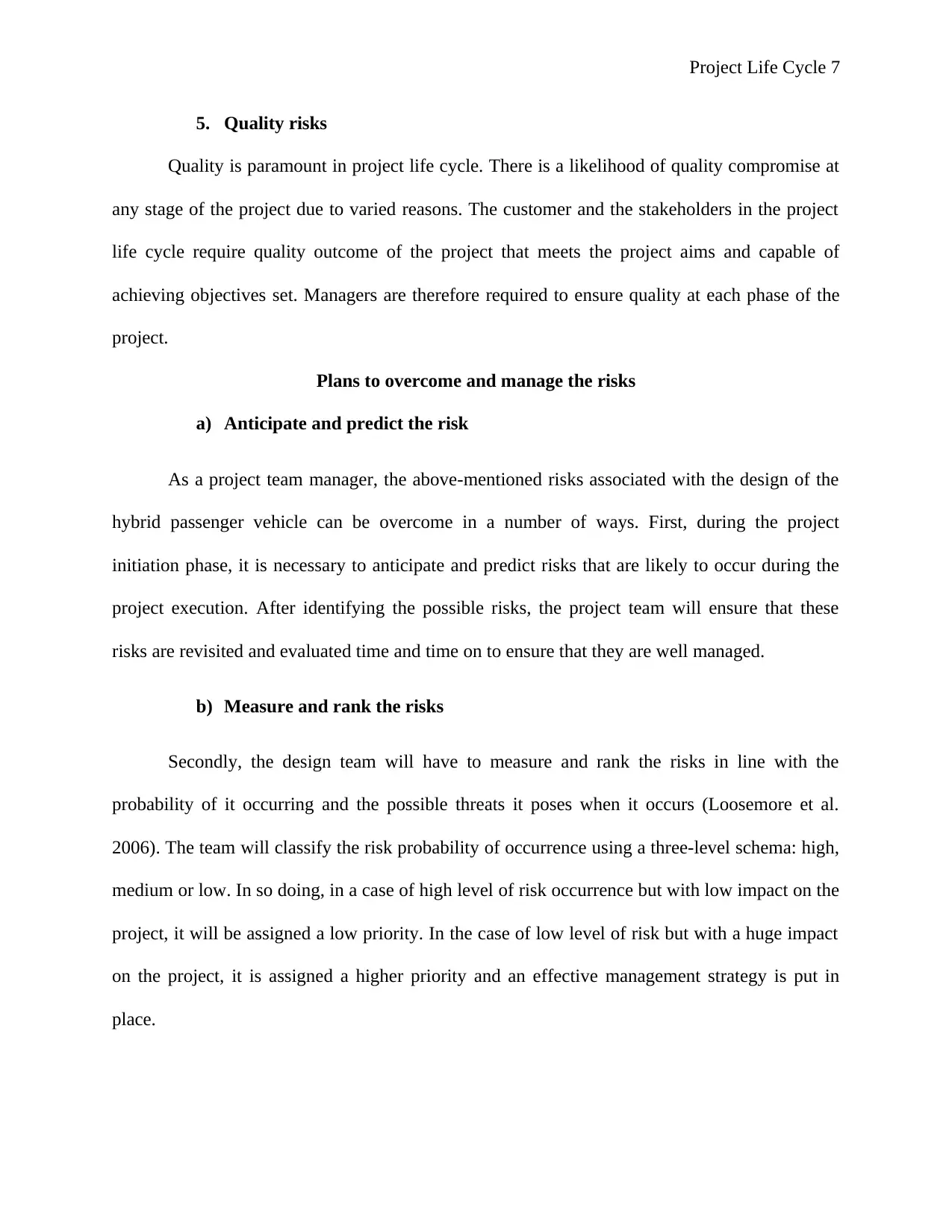
Project Life Cycle 7
5. Quality risks
Quality is paramount in project life cycle. There is a likelihood of quality compromise at
any stage of the project due to varied reasons. The customer and the stakeholders in the project
life cycle require quality outcome of the project that meets the project aims and capable of
achieving objectives set. Managers are therefore required to ensure quality at each phase of the
project.
Plans to overcome and manage the risks
a) Anticipate and predict the risk
As a project team manager, the above-mentioned risks associated with the design of the
hybrid passenger vehicle can be overcome in a number of ways. First, during the project
initiation phase, it is necessary to anticipate and predict risks that are likely to occur during the
project execution. After identifying the possible risks, the project team will ensure that these
risks are revisited and evaluated time and time on to ensure that they are well managed.
b) Measure and rank the risks
Secondly, the design team will have to measure and rank the risks in line with the
probability of it occurring and the possible threats it poses when it occurs (Loosemore et al.
2006). The team will classify the risk probability of occurrence using a three-level schema: high,
medium or low. In so doing, in a case of high level of risk occurrence but with low impact on the
project, it will be assigned a low priority. In the case of low level of risk but with a huge impact
on the project, it is assigned a higher priority and an effective management strategy is put in
place.
5. Quality risks
Quality is paramount in project life cycle. There is a likelihood of quality compromise at
any stage of the project due to varied reasons. The customer and the stakeholders in the project
life cycle require quality outcome of the project that meets the project aims and capable of
achieving objectives set. Managers are therefore required to ensure quality at each phase of the
project.
Plans to overcome and manage the risks
a) Anticipate and predict the risk
As a project team manager, the above-mentioned risks associated with the design of the
hybrid passenger vehicle can be overcome in a number of ways. First, during the project
initiation phase, it is necessary to anticipate and predict risks that are likely to occur during the
project execution. After identifying the possible risks, the project team will ensure that these
risks are revisited and evaluated time and time on to ensure that they are well managed.
b) Measure and rank the risks
Secondly, the design team will have to measure and rank the risks in line with the
probability of it occurring and the possible threats it poses when it occurs (Loosemore et al.
2006). The team will classify the risk probability of occurrence using a three-level schema: high,
medium or low. In so doing, in a case of high level of risk occurrence but with low impact on the
project, it will be assigned a low priority. In the case of low level of risk but with a huge impact
on the project, it is assigned a higher priority and an effective management strategy is put in
place.
Paraphrase This Document
Need a fresh take? Get an instant paraphrase of this document with our AI Paraphraser
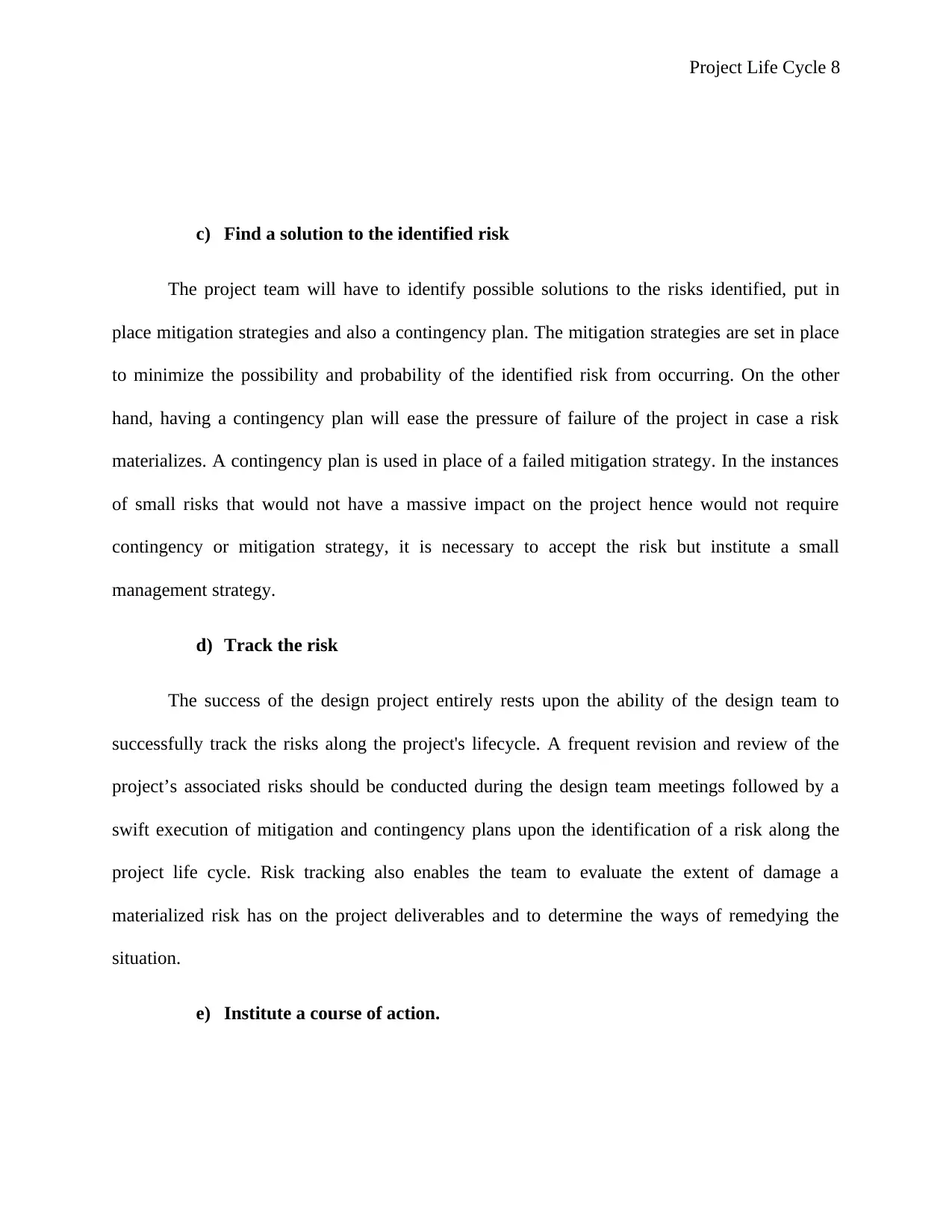
Project Life Cycle 8
c) Find a solution to the identified risk
The project team will have to identify possible solutions to the risks identified, put in
place mitigation strategies and also a contingency plan. The mitigation strategies are set in place
to minimize the possibility and probability of the identified risk from occurring. On the other
hand, having a contingency plan will ease the pressure of failure of the project in case a risk
materializes. A contingency plan is used in place of a failed mitigation strategy. In the instances
of small risks that would not have a massive impact on the project hence would not require
contingency or mitigation strategy, it is necessary to accept the risk but institute a small
management strategy.
d) Track the risk
The success of the design project entirely rests upon the ability of the design team to
successfully track the risks along the project's lifecycle. A frequent revision and review of the
project’s associated risks should be conducted during the design team meetings followed by a
swift execution of mitigation and contingency plans upon the identification of a risk along the
project life cycle. Risk tracking also enables the team to evaluate the extent of damage a
materialized risk has on the project deliverables and to determine the ways of remedying the
situation.
e) Institute a course of action.
c) Find a solution to the identified risk
The project team will have to identify possible solutions to the risks identified, put in
place mitigation strategies and also a contingency plan. The mitigation strategies are set in place
to minimize the possibility and probability of the identified risk from occurring. On the other
hand, having a contingency plan will ease the pressure of failure of the project in case a risk
materializes. A contingency plan is used in place of a failed mitigation strategy. In the instances
of small risks that would not have a massive impact on the project hence would not require
contingency or mitigation strategy, it is necessary to accept the risk but institute a small
management strategy.
d) Track the risk
The success of the design project entirely rests upon the ability of the design team to
successfully track the risks along the project's lifecycle. A frequent revision and review of the
project’s associated risks should be conducted during the design team meetings followed by a
swift execution of mitigation and contingency plans upon the identification of a risk along the
project life cycle. Risk tracking also enables the team to evaluate the extent of damage a
materialized risk has on the project deliverables and to determine the ways of remedying the
situation.
e) Institute a course of action.
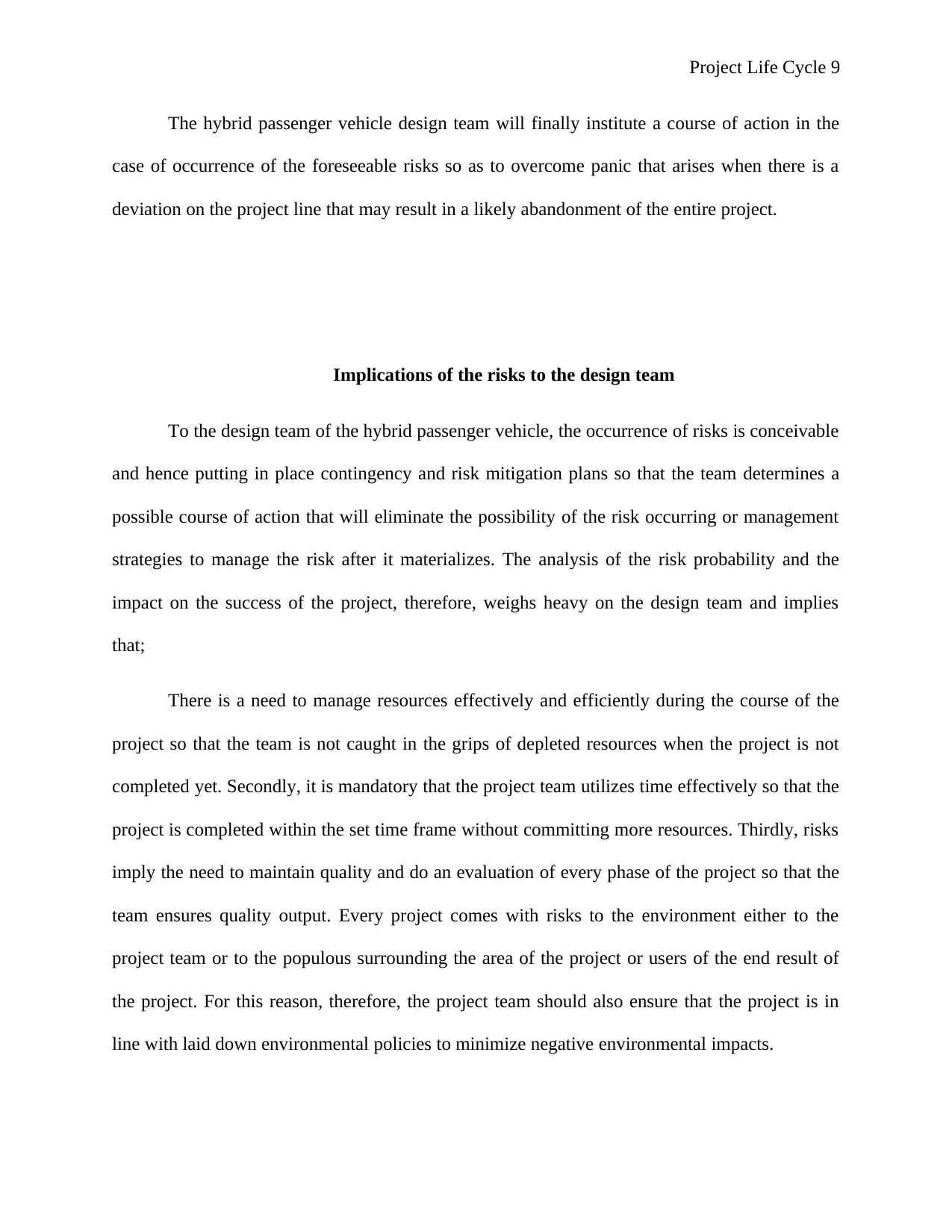
Project Life Cycle 9
The hybrid passenger vehicle design team will finally institute a course of action in the
case of occurrence of the foreseeable risks so as to overcome panic that arises when there is a
deviation on the project line that may result in a likely abandonment of the entire project.
Implications of the risks to the design team
To the design team of the hybrid passenger vehicle, the occurrence of risks is conceivable
and hence putting in place contingency and risk mitigation plans so that the team determines a
possible course of action that will eliminate the possibility of the risk occurring or management
strategies to manage the risk after it materializes. The analysis of the risk probability and the
impact on the success of the project, therefore, weighs heavy on the design team and implies
that;
There is a need to manage resources effectively and efficiently during the course of the
project so that the team is not caught in the grips of depleted resources when the project is not
completed yet. Secondly, it is mandatory that the project team utilizes time effectively so that the
project is completed within the set time frame without committing more resources. Thirdly, risks
imply the need to maintain quality and do an evaluation of every phase of the project so that the
team ensures quality output. Every project comes with risks to the environment either to the
project team or to the populous surrounding the area of the project or users of the end result of
the project. For this reason, therefore, the project team should also ensure that the project is in
line with laid down environmental policies to minimize negative environmental impacts.
The hybrid passenger vehicle design team will finally institute a course of action in the
case of occurrence of the foreseeable risks so as to overcome panic that arises when there is a
deviation on the project line that may result in a likely abandonment of the entire project.
Implications of the risks to the design team
To the design team of the hybrid passenger vehicle, the occurrence of risks is conceivable
and hence putting in place contingency and risk mitigation plans so that the team determines a
possible course of action that will eliminate the possibility of the risk occurring or management
strategies to manage the risk after it materializes. The analysis of the risk probability and the
impact on the success of the project, therefore, weighs heavy on the design team and implies
that;
There is a need to manage resources effectively and efficiently during the course of the
project so that the team is not caught in the grips of depleted resources when the project is not
completed yet. Secondly, it is mandatory that the project team utilizes time effectively so that the
project is completed within the set time frame without committing more resources. Thirdly, risks
imply the need to maintain quality and do an evaluation of every phase of the project so that the
team ensures quality output. Every project comes with risks to the environment either to the
project team or to the populous surrounding the area of the project or users of the end result of
the project. For this reason, therefore, the project team should also ensure that the project is in
line with laid down environmental policies to minimize negative environmental impacts.
⊘ This is a preview!⊘
Do you want full access?
Subscribe today to unlock all pages.

Trusted by 1+ million students worldwide
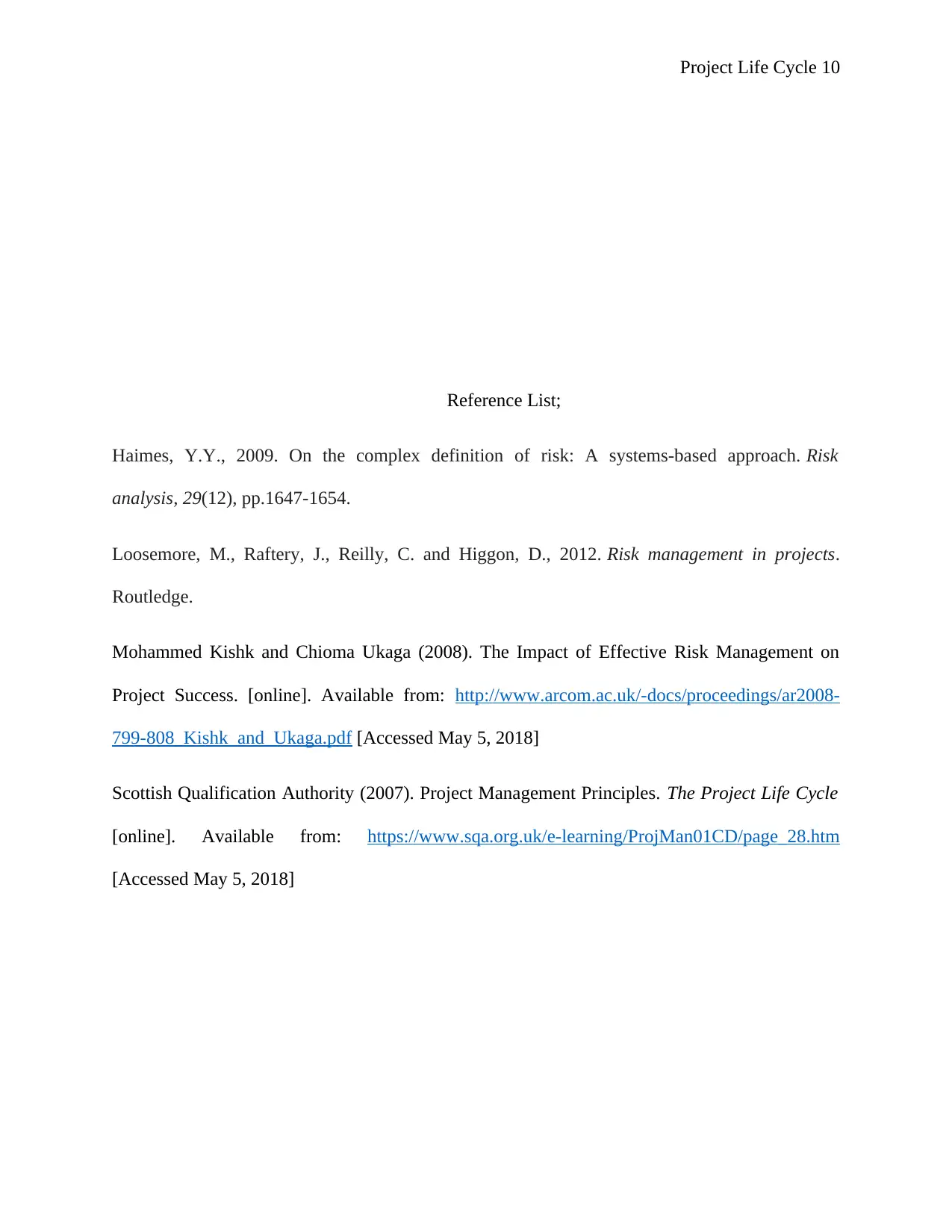
Project Life Cycle 10
Reference List;
Haimes, Y.Y., 2009. On the complex definition of risk: A systems‐based approach. Risk
analysis, 29(12), pp.1647-1654.
Loosemore, M., Raftery, J., Reilly, C. and Higgon, D., 2012. Risk management in projects.
Routledge.
Mohammed Kishk and Chioma Ukaga (2008). The Impact of Effective Risk Management on
Project Success. [online]. Available from: http://www.arcom.ac.uk/-docs/proceedings/ar2008-
799-808_Kishk_and_Ukaga.pdf [Accessed May 5, 2018]
Scottish Qualification Authority (2007). Project Management Principles. The Project Life Cycle
[online]. Available from: https://www.sqa.org.uk/e-learning/ProjMan01CD/page_28.htm
[Accessed May 5, 2018]
Reference List;
Haimes, Y.Y., 2009. On the complex definition of risk: A systems‐based approach. Risk
analysis, 29(12), pp.1647-1654.
Loosemore, M., Raftery, J., Reilly, C. and Higgon, D., 2012. Risk management in projects.
Routledge.
Mohammed Kishk and Chioma Ukaga (2008). The Impact of Effective Risk Management on
Project Success. [online]. Available from: http://www.arcom.ac.uk/-docs/proceedings/ar2008-
799-808_Kishk_and_Ukaga.pdf [Accessed May 5, 2018]
Scottish Qualification Authority (2007). Project Management Principles. The Project Life Cycle
[online]. Available from: https://www.sqa.org.uk/e-learning/ProjMan01CD/page_28.htm
[Accessed May 5, 2018]
1 out of 10
Related Documents
Your All-in-One AI-Powered Toolkit for Academic Success.
+13062052269
info@desklib.com
Available 24*7 on WhatsApp / Email
![[object Object]](/_next/static/media/star-bottom.7253800d.svg)
Unlock your academic potential
Copyright © 2020–2025 A2Z Services. All Rights Reserved. Developed and managed by ZUCOL.




